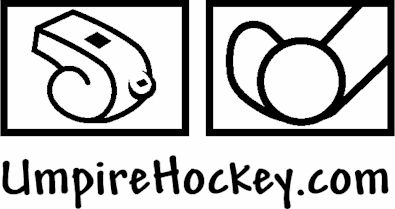
Rules and Briefings
Field Hockey Rules Changes (NFHS | USA)
By UmpireHockey.com
Feb 8, 2014 - 2:30:17 PM
Rules changes approved by the National Federation of State High School Associations (NFHS) Field Hockey Rules Committee during its January 15-17 meeting in Indianapolis centered around the official game clock and location of where play resumes after stoppage. The recommended rules changes were subsequently approved by the NFHS Board of Directors.
"More and more [field hockey] games are being played on football fields with pristine field conditions, larger press boxes and large scoreboards -- in some cases, even Jumbotron display screens that allow replays to be replayed on the screen," said Elliot Hopkins, NFHS director of sports and educational services and liaison to the Field Hockey Rules Committee.
However, Hopkins said people assume the clock on the scoreboard is the official game clock and when it reaches 00:00, the half or the game is over.
"Time doesn't end until the official's whistle blows," Hopkins said. "Penalties and other delays have to be awarded and sometimes that allows play after the 00:00 is displayed on a scoreboard clock."
[ED: This is the same as "extra time" in soccer. In NFHS soccer games, the visible clock ALWAYS runs to zero.]
Rule 2-2-4 was changed to address the official game clock and visible clock on the scoreboard. The rule now states, "When a visible scoreboard is used as the game clock, it shall be the official clock and shall remain on until the clock runs down to zero."
[ED: This is a move that gives old timers the wiggle room they need to be, well, old timers. If the visible clock, which might be on a Jumbotron installation capable of showing replays, isn't the official time, than what will be keeping the official time? The $10, battery-operated clock in the hands of an unsupervised 14-year old? If the visible clock is not the official time, the visible clock should not be turned on. Further, how are conflicts resolved relative to stopping or not stopping a visible clock before time expires? Is it up to the umpires? What if the umpires don't agree -- one wanting it stopped with 2:00 minutes remaining, the other with 1:00? What if one doesn't want it stopped and the other does?]
Rule 2-2-4 concludes by saying, "If the visible clock is not the official clock, it may be stopped prior to the end of the half/game."
[ED: This creates a great deal of ambiguity. If the umpires decide that the official time will not be the visible clock, who decides if the visible clock can or can't be turned on for unofficial use? Is it up to the coaches? ...site manager? ...home team's athletic director? What if there isn't agreement? Who decides whether or not an unofficial visible clock is stopped before it reaches 00:00?!? And, again, who decides on the amount of time to leave on the clock? Who resolves conflicts?
Every other visible clock in NFHS sports is the official clock, why not field hockey's? Not using an available visible clock for official time is NOT fan friendly and is bad for field hockey.]
An addition to Rule 2-1-1 now states that "both officials are responsible for assuring that the official game clock is correct." Previously, there was no rule coverage for the official related to game time management.
Along similar lines, "a watch suitable for timing the game" was added as a part of the official's uniform in Rule 2-1-2.
[ED: The above changes to 2-1-1 and 2-1-2 are decades overdue.]
"The emphasis is so the officials maintain control of what clock is the official clock -- either scoreboard or field -- and to have that be decided prior to the contest," Hopkins said.
Rule 8-1-1h was added to minimize risk. It states: "Players must not intentionally raise the ball from a hit except for a shot on goal." Previously, there was nothing in the rules book that prohibited a player from "chipping" the ball into the air during play or from a free hit.
Another significant rules change was made to the bully, or the restarting play after any stoppage (injury, unintended whistle, etc.). Rule 5-2-1b1 now states, "The bully shall take place at or near where play on the ball ended at least 16 yards from the end line, 5 yards from the sideline and 5 yards from the circle."
Other rules changes include the following: - Rule 1-7-4 now restricts goalkeepers from making a play outside the 25-yard area, except when taking a penalty stroke
- Rule 5-2-1b5 further clarified that a bully should be taken 5 yards outside the circle
- Rule 9-1-3 was deleted and combined with 9-1-2, which now states that if the defense is awarded a free hit within 16 yards of the end line or in the circle, the hit may be taken anywhere in line with the violation up to 16 yards from the inner edge of the end line. Opposing players must be at least 5 yards away from the spot where taken
- Rule 11-2-10 now clarifies that continued delays during a penalty stroke by the attacking team will result in no goal allowed and the end of the penalty stroke. If the defending team delays, the use of the card progression would be appropriate to enforce
- The visiting team shall always call any coin toss during tie-breaking procedures
According to the 2012-13 NFHS High School Athletics Participation Survey, 62,171 students participated in field hockey nationwide.
NOTE: This was largely taken from a press release was written by Megan Filipowski, an intern in the NFHS Publications/Communications Department and a graduate student at Indiana University Purdue University - Indianapolis.
Copyright © 2002-
UmpireHockey.com
| 